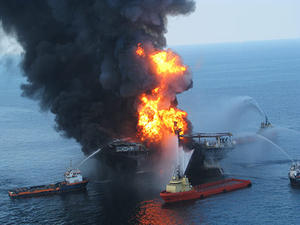Gulf of Mexico oil spillFaulty cement plug may have caused oil rig explosion
As part of the oil drilling process, a cement plug is placed at the bottom of the well in order temporarily to shut it off prior to pumping the oil out; while the cement is drying, mud is loaded into the top of the well to prevent a gas surge; before removing the mud, pressure tests are carried out to ensure the plug is holding; James Dupree, a senior BP official, has claimed that the results of the tests on the Gulf of Mexico plug, carried out on 20 April, were inconclusive — yet the mud was removed

Before the collapse // Source: treehugger.com
A failed cement plug could have contributed to the blowout of an exploration well in the Gulf of Mexico, which is still pumping out oil one month on.
Congressional hearings held earlier this month heard that key safety tests carried out as the well was being dug may have been inconclusive.
Phil McKenna writes that as part of the drilling process, a cement plug is placed at the bottom of the well in order temporarily to shut it off prior to pumping the oil out. While the cement is drying, mud is loaded into the top of the well to prevent a gas surge. Before removing the mud, pressure tests are carried out to ensure the plug is holding.
James Dupree, a senior BP official, has claimed that the results of the tests on the Gulf of Mexico plug, carried out on 20 April, were inconclusive. Yet the mud was removed — which may be what led to a ball of gas rushing up the well and exploding at the surface. “It’s like taking out your most critical defense when you are being attacked,” Satish Nagarajaiah of Rice University told McKenna.
Despite Dupree’s testimony, the exact sequence of events is proving difficult to pin down. Lawyers for BP later contacted the congressional committee and provided a different account. They say additional pressure tests were carried out, and that officials determined these justified proceeding with well operations.
